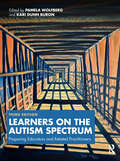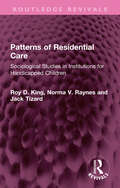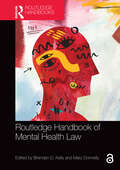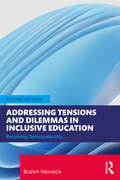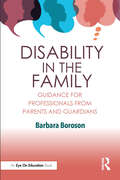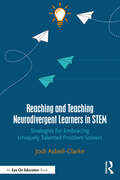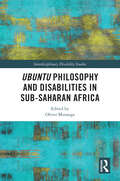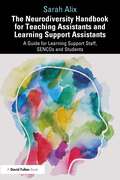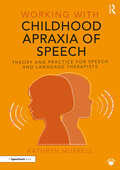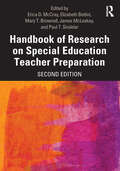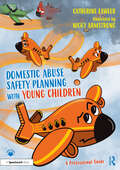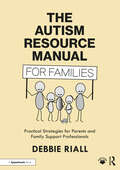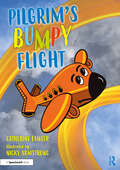- Table View
- List View
Learners on the Autism Spectrum: Preparing Educators and Related Practitioners
This third edition is a foundational text that has been updated and expanded to prepare educators, therapists, and other care providers with vital knowledge and practical skills to support diverse learners on the autism spectrum. Covering an expanse of fundamental topics, this edited volume features new directions in research and practice that are essential to understanding the ever-changing field of autism. Along with new chapters from leading experts (including those who identify as autistic), this revision places greater emphasis on the intersection of neurodevelopmental differences with ethnicity, race, culture, language, gender expression, and socioeconomic experiences. The diverse disciplines and perspectives presented provide a foundation on how these students learn and how best to provide them with effective teaching, therapy, and social supports. This book equips readers with knowledge and skill to competently apply reflective and humanistic practices that prioritize the preferences, strengths, and values of autistic learners from all walks of life.
Learners on the Autism Spectrum: Preparing Educators and Related Practitioners
by Pamela Wolfberg Kari Dunn BuronThis third edition is a foundational text that has been updated and expanded to prepare educators, therapists, and other care providers with vital knowledge and practical skills to support diverse learners on the autism spectrum. Covering an expanse of fundamental topics, this edited volume features new directions in research and practice that are essential to understanding the ever-changing field of autism. Along with new chapters from leading experts (including those who identify as autistic), this revision places greater emphasis on the intersection of neurodevelopmental differences with ethnicity, race, culture, language, gender expression, and socioeconomic experiences. The diverse disciplines and perspectives presented provide a foundation on how these students learn and how best to provide them with effective teaching, therapy, and social supports. This book equips readers with knowledge and skill to competently apply reflective and humanistic practices that prioritize the preferences, strengths, and values of autistic learners from all walks of life.
Patterns of Residential Care: Sociological Studies in Institutions for Handicapped Children (Routledge Revivals)
by Roy D. King Norma V. Raynes Jack TizardOriginally published in 1971, this title describes a series of studies dealing with the upbringing of children in residential institutions. Most work has been carried out in institutions for children with learning disabilities, although units caring for able but deprived children and children with physical disabilities have also been examined. The investigations have been concerned with the detailed nature of different institutional environments – that is, the routine patterns of daily life in hospital wards, hostels and cottages of children’s homes – rather than with the effects of specific child-rearing practices upon the intellectual, emotional and social development of the children. The more precise delineation of ‘the environment’ is an essential step towards the evaluation of residential services and the interpretation of their effects upon those who use them, yet this is an area which had received little systematic attention from social scientists at the time. This book is a re-issue originally published in 1971. The language used is a reflection of its era and no offence is meant by the Publishers to any reader by this re-publication.
Patterns of Residential Care: Sociological Studies in Institutions for Handicapped Children (Routledge Revivals)
by Roy D. King Norma V. Raynes Jack TizardOriginally published in 1971, this title describes a series of studies dealing with the upbringing of children in residential institutions. Most work has been carried out in institutions for children with learning disabilities, although units caring for able but deprived children and children with physical disabilities have also been examined. The investigations have been concerned with the detailed nature of different institutional environments – that is, the routine patterns of daily life in hospital wards, hostels and cottages of children’s homes – rather than with the effects of specific child-rearing practices upon the intellectual, emotional and social development of the children. The more precise delineation of ‘the environment’ is an essential step towards the evaluation of residential services and the interpretation of their effects upon those who use them, yet this is an area which had received little systematic attention from social scientists at the time. This book is a re-issue originally published in 1971. The language used is a reflection of its era and no offence is meant by the Publishers to any reader by this re-publication.
Routledge Handbook of Mental Health Law (Routledge Handbooks in Law)
Mental health law is a rapidly evolving area of practice and research, with growing global dimensions. This work reflects the increasing importance of this field, critically discussing key issues of controversy and debate, and providing up-to-date analysis of cutting-edge developments in Africa, Asia, Europe, the Americas, and Australia.This is a timely moment for this book to appear. The United Nations’ Convention on the Rights of Persons with Disabilities (2006) sought to transform the landscape in which mental health law is developed and implemented. This Convention, along with other developments, has, to varying degrees, informed sweeping legislative reforms in many countries around the world. These and other developments are discussed here. Contributors come from a wide range of countries and a variety of academic backgrounds including ethics, law, philosophy, psychiatry, and psychology. Some contributions are also informed by lived experience, whether in person or as family members. The result is a rich, polyphonic, and sometimes discordant account of what mental health law is and what it might be.The Handbook is aimed at mental health scholars and practitioners as well as students of law, human rights, disability studies, and psychiatry, and campaigners and law- and policy-makers.
Routledge Handbook of Mental Health Law (Routledge Handbooks in Law)
by Brendan D. Kelly and Mary DonnellyMental health law is a rapidly evolving area of practice and research, with growing global dimensions. This work reflects the increasing importance of this field, critically discussing key issues of controversy and debate, and providing up-to-date analysis of cutting-edge developments in Africa, Asia, Europe, the Americas, and Australia.This is a timely moment for this book to appear. The United Nations’ Convention on the Rights of Persons with Disabilities (2006) sought to transform the landscape in which mental health law is developed and implemented. This Convention, along with other developments, has, to varying degrees, informed sweeping legislative reforms in many countries around the world. These and other developments are discussed here. Contributors come from a wide range of countries and a variety of academic backgrounds including ethics, law, philosophy, psychiatry, and psychology. Some contributions are also informed by lived experience, whether in person or as family members. The result is a rich, polyphonic, and sometimes discordant account of what mental health law is and what it might be.The Handbook is aimed at mental health scholars and practitioners as well as students of law, human rights, disability studies, and psychiatry, and campaigners and law- and policy-makers.
Addressing Tensions and Dilemmas in Inclusive Education: Resolving Democratically
by Brahm NorwichThis updated second edition of Addressing Tensions and Dilemmas in Inclusive Education further develops the critical analysis of the initial edition that integrates the interaction between different perspectives and positions in the field of inclusive education. This key resource expands the arguments present in the first edition with clearer implications about how to address tensions and dilemmas in inclusive education, and resolve them through democratic deliberation. Based on contemporary research, theory and policy, as well as responding to current perspectives towards the education of children and young people with learning difficulties and disabilities, Brahm Norwich extends and refines the original core argument of the previous edition – the practical realisation of inclusion involves tensions and dilemmas that have to be addressed and resolved. This core analysis focuses on:- identification and classification- current national and international conceptions- pedagogic and curriculum issues- organisation of schooling- parental and student perspectives and the contribution of research to policy and practice.Re-engaging with the fundamental issues in the field and providing a coherent perspective that recognises and justifies the inter-connection between specialised and general school provision, this accessible new edition will be of interest to all students and researchers of inclusive education.
Addressing Tensions and Dilemmas in Inclusive Education: Resolving Democratically
by Brahm NorwichThis updated second edition of Addressing Tensions and Dilemmas in Inclusive Education further develops the critical analysis of the initial edition that integrates the interaction between different perspectives and positions in the field of inclusive education. This key resource expands the arguments present in the first edition with clearer implications about how to address tensions and dilemmas in inclusive education, and resolve them through democratic deliberation. Based on contemporary research, theory and policy, as well as responding to current perspectives towards the education of children and young people with learning difficulties and disabilities, Brahm Norwich extends and refines the original core argument of the previous edition – the practical realisation of inclusion involves tensions and dilemmas that have to be addressed and resolved. This core analysis focuses on:- identification and classification- current national and international conceptions- pedagogic and curriculum issues- organisation of schooling- parental and student perspectives and the contribution of research to policy and practice.Re-engaging with the fundamental issues in the field and providing a coherent perspective that recognises and justifies the inter-connection between specialised and general school provision, this accessible new edition will be of interest to all students and researchers of inclusive education.
Disability in the Family: Guidance for Professionals from Parents and Guardians
by Barbara BorosonThis insightful guide shows professionals how to collaborate with parents and guardians of children with disabilities in empathic, respectful, knowledgeable, and supportive ways. Packed with first-hand accounts and advice from parents and guardians, this book shines a light on lived experiences and reveals paths toward meeting families where they are in order to move forward together. Boroson emphasizes that appreciating the real needs of these families is a crucial step beyond mere adherence to a generic set of professional best practices or principles. Whether working in the field of medicine, education, law, mental health, or related services—in any capacity—readers will come away with the holistic knowledge, inclusive language, productive strategies, and differentiated understanding needed to work effectively with the diverse families they serve. Included is a robust array of resources for families, such as books, articles, associations, organizations, and support networks, along with a website for additional, up-to-date resources.
Disability in the Family: Guidance for Professionals from Parents and Guardians
by Barbara BorosonThis insightful guide shows professionals how to collaborate with parents and guardians of children with disabilities in empathic, respectful, knowledgeable, and supportive ways. Packed with first-hand accounts and advice from parents and guardians, this book shines a light on lived experiences and reveals paths toward meeting families where they are in order to move forward together. Boroson emphasizes that appreciating the real needs of these families is a crucial step beyond mere adherence to a generic set of professional best practices or principles. Whether working in the field of medicine, education, law, mental health, or related services—in any capacity—readers will come away with the holistic knowledge, inclusive language, productive strategies, and differentiated understanding needed to work effectively with the diverse families they serve. Included is a robust array of resources for families, such as books, articles, associations, organizations, and support networks, along with a website for additional, up-to-date resources.
Reaching and Teaching Neurodivergent Learners in STEM: Strategies for Embracing Uniquely Talented Problem Solvers
by Jodi Asbell-ClarkeProviding salient stories and practical strategies, this book empowers educators to embrace the unique talents of neurodivergent learners in science, technology, engineering, and mathematics (STEM). An exploration of the exciting opportunities neurodiversity presents to build an innovative workforce is grounded in a large body of research from psychology, neuroscience, and education. Author Jodi Asbell-Clarke presents individual examples of neurodivergent journeys in STEM to establish evidence-based connections between neurodiversity and the types of innovative problem-solving skills needed in today’s workforce. The featured stories come directly from the author’s many years in inclusive classrooms with STEM teachers along with interviews from many neurodivergent professionals in STEM. Teachers will learn how to embrace the unique brilliance and potential of the neurodivergent learners in their classroom, working against historic marginalization and deficit-based perspectives of neurodiversity within the education system. Featuring illustrations of classroom-designed tools and materials alongside basic strategies to support executive function and emotion in learning, this book will help you nurture the talents of your neurodivergent learners and recognize their unique potential within STEM. Ideal for K-12 classroom teachers, special educators, learning specialists, psychologists, and school administrators.
Reaching and Teaching Neurodivergent Learners in STEM: Strategies for Embracing Uniquely Talented Problem Solvers
by Jodi Asbell-ClarkeProviding salient stories and practical strategies, this book empowers educators to embrace the unique talents of neurodivergent learners in science, technology, engineering, and mathematics (STEM). An exploration of the exciting opportunities neurodiversity presents to build an innovative workforce is grounded in a large body of research from psychology, neuroscience, and education. Author Jodi Asbell-Clarke presents individual examples of neurodivergent journeys in STEM to establish evidence-based connections between neurodiversity and the types of innovative problem-solving skills needed in today’s workforce. The featured stories come directly from the author’s many years in inclusive classrooms with STEM teachers along with interviews from many neurodivergent professionals in STEM. Teachers will learn how to embrace the unique brilliance and potential of the neurodivergent learners in their classroom, working against historic marginalization and deficit-based perspectives of neurodiversity within the education system. Featuring illustrations of classroom-designed tools and materials alongside basic strategies to support executive function and emotion in learning, this book will help you nurture the talents of your neurodivergent learners and recognize their unique potential within STEM. Ideal for K-12 classroom teachers, special educators, learning specialists, psychologists, and school administrators.
Ubuntu Philosophy and Disabilities in Sub-Saharan Africa (Interdisciplinary Disability Studies)
This book uses Ubuntu philosophy to illuminate the voices of people with disabilities from Sub-Saharan Africa. Disability literature is largely dominated by scholars and studies from the Global North, and these studies are largely informed by Global North theories and concepts. Although disability literature in the Global South is now fast growing, most studies continue to utilise conceptual, theoretical, and philosophical frameworks that are framed within Global North contexts. This presents two major challenges: Firstly, the voices of people with disabilities in the Global South remain on the fringes of disability discourses. Secondly, when their voices are heard, their realities are distorted. This edited book, consisting of 11 chapters, provides case studies from Botswana, Ghana, Lesotho, Uganda, and South Africa, explores disability in various fields: Inclusive education, higher education, environment, Open Distance Learning, and Technical and Vocational Education and Technical Colleges. The book contributes to the ways in which disability is understood and experienced in the Global South thereby challenging the Western hegemonic discourses on disability. This collection of contributions will be of interest to all scholars and students of disability studies, development studies, medical sociology, and African studies.
Ubuntu Philosophy and Disabilities in Sub-Saharan Africa (Interdisciplinary Disability Studies)
by Oliver MutangaThis book uses Ubuntu philosophy to illuminate the voices of people with disabilities from Sub-Saharan Africa. Disability literature is largely dominated by scholars and studies from the Global North, and these studies are largely informed by Global North theories and concepts. Although disability literature in the Global South is now fast growing, most studies continue to utilise conceptual, theoretical, and philosophical frameworks that are framed within Global North contexts. This presents two major challenges: Firstly, the voices of people with disabilities in the Global South remain on the fringes of disability discourses. Secondly, when their voices are heard, their realities are distorted. This edited book, consisting of 11 chapters, provides case studies from Botswana, Ghana, Lesotho, Uganda, and South Africa, explores disability in various fields: Inclusive education, higher education, environment, Open Distance Learning, and Technical and Vocational Education and Technical Colleges. The book contributes to the ways in which disability is understood and experienced in the Global South thereby challenging the Western hegemonic discourses on disability. This collection of contributions will be of interest to all scholars and students of disability studies, development studies, medical sociology, and African studies.
The Neurodiversity Handbook for Teaching Assistants and Learning Support Assistants: A Guide for Learning Support Staff, SENCOs and Students
by Sarah AlixThis highly practical book supports the knowledge and development of teaching assistants and learning support assistants (TAs/LSAs) in their understanding of neurodivergent pupils. Considering a neurodivergent world is vital in society today, and even more so in the classroom. Starting with a model of difference rather than deficit and highlighting the complexities involved, this accessible resource focuses on effective strategies to support these pupils and explores the vital role of learning support in a range of different contexts. Rich in pedagogical features, this book includes chapter objectives, areas for the reader to reflect upon, links throughout to the Teaching Assistant Standards and case studies for the reader to examine. Each chapter also has a further reading section which will include links to articles, websites, and organisations that can aid and support the development of TAs and LSAs. This important work will provide Special Educational Needs Co-ordinators (SENCos) with a framework to support their support staff in the classroom.
The Neurodiversity Handbook for Teaching Assistants and Learning Support Assistants: A Guide for Learning Support Staff, SENCOs and Students
by Sarah AlixThis highly practical book supports the knowledge and development of teaching assistants and learning support assistants (TAs/LSAs) in their understanding of neurodivergent pupils. Considering a neurodivergent world is vital in society today, and even more so in the classroom. Starting with a model of difference rather than deficit and highlighting the complexities involved, this accessible resource focuses on effective strategies to support these pupils and explores the vital role of learning support in a range of different contexts. Rich in pedagogical features, this book includes chapter objectives, areas for the reader to reflect upon, links throughout to the Teaching Assistant Standards and case studies for the reader to examine. Each chapter also has a further reading section which will include links to articles, websites, and organisations that can aid and support the development of TAs and LSAs. This important work will provide Special Educational Needs Co-ordinators (SENCos) with a framework to support their support staff in the classroom.
Working with Childhood Apraxia of Speech: Theory and Practice for Speech and Language Therapists (Working With)
by Kathryn MurrellThis resource will lead the reader through the practicalities of assessment, diagnosis, and therapeutic intervention for children of all ages with features of childhood apraxia of speech. It provides the theory and underlying principles upon which to work with children who have this fascinating but challenging disorder in collaboration with families and schools.Chapters are clearly laid out, with hands on activities for intervention and helpful summaries. There is a focus on alternative and augmentative means of communication and multidisciplinary working, as well as a wealth of case studies and teaching notes for training other professionals. Fresh ways of working are addressed, such as the use of teletherapy and other techniques such as group therapy and the consultative approach are discussed.Key features include: A theoretical overview of current thinking about childhood apraxia of speech A structured assessment format with a chapter specifically focused on how to take a detailed speech sample Clear guidance on how to make a differential diagnosis How to spot early indicators of childhood apraxia of speech Advice sheets for parents and schools Downloadable record forms for case history taking and assessment. This book can be read cover to cover or dipped into for quick and easy therapy ideas and is presented in an easy-to-read format, with chapters broken down into bite-sized chunks. It is an essential handbook for all speech and language therapists and students, whatever their level of experience.
Working with Childhood Apraxia of Speech: Theory and Practice for Speech and Language Therapists (Working With)
by Kathryn MurrellThis resource will lead the reader through the practicalities of assessment, diagnosis, and therapeutic intervention for children of all ages with features of childhood apraxia of speech. It provides the theory and underlying principles upon which to work with children who have this fascinating but challenging disorder in collaboration with families and schools.Chapters are clearly laid out, with hands on activities for intervention and helpful summaries. There is a focus on alternative and augmentative means of communication and multidisciplinary working, as well as a wealth of case studies and teaching notes for training other professionals. Fresh ways of working are addressed, such as the use of teletherapy and other techniques such as group therapy and the consultative approach are discussed.Key features include: A theoretical overview of current thinking about childhood apraxia of speech A structured assessment format with a chapter specifically focused on how to take a detailed speech sample Clear guidance on how to make a differential diagnosis How to spot early indicators of childhood apraxia of speech Advice sheets for parents and schools Downloadable record forms for case history taking and assessment. This book can be read cover to cover or dipped into for quick and easy therapy ideas and is presented in an easy-to-read format, with chapters broken down into bite-sized chunks. It is an essential handbook for all speech and language therapists and students, whatever their level of experience.
Handbook of Research on Special Education Teacher Preparation
by Erica D. McCray Elizabeth Bettini Mary T. Brownell James McLeskey Paul T. SindelarThe new edition of this landmark text expands our current understanding of teacher education broadly by providing an in-depth look at the most up-to-date research on special education teacher preparation. Offering a comprehensive review of research on attracting, preparing, and sustaining personnel to effectively serve students with disabilities, it is fully updated to align with current knowledge and future perspectives on special educator development, synthesizing what we can do to continue advancing as a field. The Handbook of Research on Special Education Teacher Preparation is a great resource not only to special education faculty and the doctoral students they prepare, but also to scholars outside of special education who address questions related to special education teacher supply, demand, and attrition.
Domestic Abuse Safety Planning with Young Children: A Professional Guide (Safety Planning with Young Children)
by Catherine LawlerThis guidebook is an essential companion to the Pilgrim’s Bumpy Flight story and is designed to be read by professionals to ensure the effective and safe use of the storybook. Pilgrims Bumpy Flight has been created to help young children aged 5–7 experiencing domestic abuse, to explore the concepts of physical and emotional safety. Safety planning with a child offers a way to help them vocalise their feelings and understand what to do when something does not feel right. The professional guide will help supporting adults facilitate safety planning that is experienced as emphatically curious, safe and where the child’s opinion matters. It provides up-to-date information on domestic abuse, childhood trauma, practice tips and how to complete a safety plan with a young child using the storybook as the key vessel of communication and exploration. Key features include: • Accessible information about domestic abuse and coercive control based on the latest research. • Guidance around direct work and safety planning with young children. • Practical activities building off Pilgrim’s story, including printable material. • Things to consider and ways to use the storybook to facilitate a conversation with a child, as well as page-by-page helpers notes on the narrative. • A comprehensive list of helplines and organisations in place to support adult victims/survivors of domestic abuse. Used alongside the storybook, this professional guide is a crucial tool for the early years sector, education staff and those working in children’s services, including safeguarding officers, family support workers, social workers and children’s IDVAs. Both books should be used in tandem with agency policy, procedure and guidance.
The Autism Resource Manual for Families: Practical Strategies for Parents and Family Support Professionals
by Debbie RiallThe Autism Resource Manual for Families is a treasure trove of practical, realistic and achievable strategies to support neurodivergent young people and their families with everyday life. Clearly laid out for easy use and access, it explains autism in context and provides ideas that are relevant not just for parents and carers, but for family support workers, social workers and family intervention teams. The resource covers a wide range of situations and offers an array of supports, with key topics ranging from anxiety, behaviour, and communication, to socialising, family life, and moving towards independence. With the lived experiences of parents and autistic children and young people in mind, this empowering manual includes: A wealth of situations from daily life, clearly addressed with examples of how autistic individuals may experience these and practical strategies for effective support Encouragement for parents and mini mantras for autistic children and young people to use in different situations Strategies for supporting autistic children in daily family life, including working with siblings, family holidays and eating out Advice for helping autistic young people through school, including attendance, homework and after-school exhaustion Guidance on initiating and carrying out productive conversations, as well as downloadable resources for visual conversation support. This book will be an essential tool for parents and carers of neurodivergent children and young people, as well as family or parent support workers and family intervention teams. It will also be valuable reading for pastoral teams, CAMHS, and social workers supporting these families.
Pilgrim's Bumpy Flight: Helping Young Children Learn About Domestic Abuse Safety Planning (Safety Planning with Young Children)
by Catherine LawlerFor effective and safe use, this book should be purchased alongside the professional guidebook. Both books can be purchased together as a set, Domestic Abuse Safety Planning with Young Children: A 'Pilgrim’s Bumpy Flight' Storybook and Professional Guide [9781032357997] Pilgrim is a little plane who loves flying through the sky and zooming through big hoops with their friends. At home, however, Pilgrim experiences frightening behaviour from Jumbo, who represents the perpetrating parent, that makes them feel scared and sad. Pilgrim is comforted and guided by Jet, who represents the victim/survivor parent, to think about safety and what to do when frightening things are happening. The trauma a young child may experience from domestic abuse can impact their entire developing system, making them feel worried, frightened, and unsafe. Safety planning is an essential component of direct work with children, offering a way to help them vocalise their feelings and understand what to do when something does not feel right, and this storybook is a key vessel for communication and exploration. The story, which is rhyming and engaging, enables young children to engage in the narrative in a non-threatening way. This book aims to be accessible to all children from all families where safety planning is needed as such the characters in it are non-gendered. This beautifully illustrated storybook is a crucial tool for the early years sector, education staff and those working in children’s services, including safeguarding officers, family support workers, social workers and children’s IDVAs. This book is designed to be used alongside the companion guidebook, Domestic Abuse Safety Planning with Young Children: A Professional Guide. Both books should be used in tandem with agency policy, procedure and guidance.
Handbook of Research on Special Education Teacher Preparation
by Erica D. McCray Elizabeth Bettini Mary T. Brownell James McLeskey Paul T. SindelarThe new edition of this landmark text expands our current understanding of teacher education broadly by providing an in-depth look at the most up-to-date research on special education teacher preparation. Offering a comprehensive review of research on attracting, preparing, and sustaining personnel to effectively serve students with disabilities, it is fully updated to align with current knowledge and future perspectives on special educator development, synthesizing what we can do to continue advancing as a field. The Handbook of Research on Special Education Teacher Preparation is a great resource not only to special education faculty and the doctoral students they prepare, but also to scholars outside of special education who address questions related to special education teacher supply, demand, and attrition.
Domestic Abuse Safety Planning with Young Children: A Professional Guide (Safety Planning with Young Children)
by Catherine LawlerThis guidebook is an essential companion to the Pilgrim’s Bumpy Flight story and is designed to be read by professionals to ensure the effective and safe use of the storybook. Pilgrims Bumpy Flight has been created to help young children aged 5–7 experiencing domestic abuse, to explore the concepts of physical and emotional safety. Safety planning with a child offers a way to help them vocalise their feelings and understand what to do when something does not feel right. The professional guide will help supporting adults facilitate safety planning that is experienced as emphatically curious, safe and where the child’s opinion matters. It provides up-to-date information on domestic abuse, childhood trauma, practice tips and how to complete a safety plan with a young child using the storybook as the key vessel of communication and exploration. Key features include: • Accessible information about domestic abuse and coercive control based on the latest research. • Guidance around direct work and safety planning with young children. • Practical activities building off Pilgrim’s story, including printable material. • Things to consider and ways to use the storybook to facilitate a conversation with a child, as well as page-by-page helpers notes on the narrative. • A comprehensive list of helplines and organisations in place to support adult victims/survivors of domestic abuse. Used alongside the storybook, this professional guide is a crucial tool for the early years sector, education staff and those working in children’s services, including safeguarding officers, family support workers, social workers and children’s IDVAs. Both books should be used in tandem with agency policy, procedure and guidance.
The Autism Resource Manual for Families: Practical Strategies for Parents and Family Support Professionals
by Debbie RiallThe Autism Resource Manual for Families is a treasure trove of practical, realistic and achievable strategies to support neurodivergent young people and their families with everyday life. Clearly laid out for easy use and access, it explains autism in context and provides ideas that are relevant not just for parents and carers, but for family support workers, social workers and family intervention teams. The resource covers a wide range of situations and offers an array of supports, with key topics ranging from anxiety, behaviour, and communication, to socialising, family life, and moving towards independence. With the lived experiences of parents and autistic children and young people in mind, this empowering manual includes: A wealth of situations from daily life, clearly addressed with examples of how autistic individuals may experience these and practical strategies for effective support Encouragement for parents and mini mantras for autistic children and young people to use in different situations Strategies for supporting autistic children in daily family life, including working with siblings, family holidays and eating out Advice for helping autistic young people through school, including attendance, homework and after-school exhaustion Guidance on initiating and carrying out productive conversations, as well as downloadable resources for visual conversation support. This book will be an essential tool for parents and carers of neurodivergent children and young people, as well as family or parent support workers and family intervention teams. It will also be valuable reading for pastoral teams, CAMHS, and social workers supporting these families.
